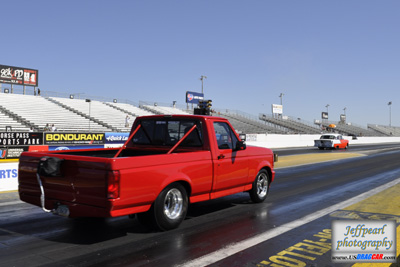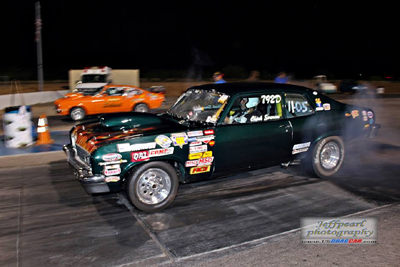 How
many times have you heard somebody proclaim that drag racing
needs to be fixed? Maybe you’ve even said it yourself.
Surprisingly enough, even though those cries can still be
heard on a weekly basis, drag racing has been fixed; it’s
just that very few people have yet to realize this to be
true.
How
many times have you heard somebody proclaim that drag racing
needs to be fixed? Maybe you’ve even said it yourself.
Surprisingly enough, even though those cries can still be
heard on a weekly basis, drag racing has been fixed; it’s
just that very few people have yet to realize this to be
true.
If
you’re an Arizona drag racer, you’ve undoubtedly
heard of American DRAGCAR. But unless you are a DRAGCAR
racer, you likely don’t know all that there is to
know about this one of a kind organization. Even after
6 years of statewide competition, there still are racers
asking what it is and how it works. Unfortunately, the
complexity of the rules when you start to read into them
tends to scare today’s racers off into the bracket
lanes but the actual goal of DRAGCAR is to revive the
original “first one there wins” concept while
opening up the competition to racers of all racing budgets
and at the same time restoring the spectator appeal that
may bring people back into the stands of the local weekend
events.
 During
its first 10 years, drag races were won by the racer reaching
the finish line first, period. But over the past 50 years,
drag racing’s original “first one there wins”
premise has slowly been chipped away to the point that
virtually 90 percent of all drag racing competitions are
today contested on a breakout format where nearly 50 percent
of all races are actually won by the racers NOT getting
to the finish line first. Is it really any wonder why
the stands are empty at the local Saturday night bracket
races? Drag racing has become no longer an exciting exhibition
of power so much as it has just been turned into a fun
game of numbers. How many people really care about crunching
the numbers when they are supposed to be watching a race?
People just want to see racers racing all out to get to
the finish line first, and racers want to do just that.
That’s why the outlaw craze has taking off so wildly
in recent years.
During
its first 10 years, drag races were won by the racer reaching
the finish line first, period. But over the past 50 years,
drag racing’s original “first one there wins”
premise has slowly been chipped away to the point that
virtually 90 percent of all drag racing competitions are
today contested on a breakout format where nearly 50 percent
of all races are actually won by the racers NOT getting
to the finish line first. Is it really any wonder why
the stands are empty at the local Saturday night bracket
races? Drag racing has become no longer an exciting exhibition
of power so much as it has just been turned into a fun
game of numbers. How many people really care about crunching
the numbers when they are supposed to be watching a race?
People just want to see racers racing all out to get to
the finish line first, and racers want to do just that.
That’s why the outlaw craze has taking off so wildly
in recent years.
In
truth, there are now only about 4 options available to
racers who want to race in a non-breakout format, and
all 4 are quite expensive. First and foremost we have
Pro racing where $100,000-$200,000 vehicles are needed
along with multi-million dollar seasonal budgets in order
to stand a chance at a season championship. But in these
categories (Top Alcohol and Pro Mod included), the type
of vehicle options open to racers are very limited, so
if you don’t want to run one of those types of vehicles,
you don’t have a class. Then we have the more recently
popularized Outlaw racing where you still need a $50,000-$200,000
vehicle along with who knows how much of a racing budget
may be needed to compete at anywhere from a local or regional
level to the national level. But again, your choice of
vehicle types and engine combination is still quite limited
as you will need to bring with you as much as everybody
else has in the way of cubic inch, aspiration, and vehicle
weight. Now more recently, No-Prep Outlaw racing has started
to take off nationwide and while these competitions are
sometimes being won by the racer bringing less horsepower
to the table, they still require sub 9-second capable
vehicles which, while quite less expensive then the typical
6 and 7 second Outlaw cars, they are still not really
affordable to a great many racers, and again, there is
a limitation to the types of vehicles being accepted into
this lane of non-breakout drag racing. And of course there
is Comp Eliminator which claims to be a Sportsman category
but the truth of it all is that it takes a $100,000-$200,000
vehicle to qualify in the field and likely almost as much
as a Pro racer’s budget to compete at the national
level. So where does a racer go who has a 3600 pound Chevelle
with a mild 355 small block that runs high 11’s,
or the racer who has a nicely built tube chassis naturally
aspirated 565 big block Beretta that runs 8.60’s
but is a dedicated drag car having not one consideration
for street use? Are these racers to be forever relegated
to the handicap and heads-up breakout brackets?
American
DRAGCAR says “NO”! DRAGCAR is where racers
of any type of vehicle and racing budget can actually
drag race in true “first one there wins” fashion
without having to tolerate the game of the breakout. And
with its 2 very different non-breakout formats available
to racers, DRAGCAR’s DragCar Eliminator and SportComp
Eliminator formats can accommodate virtually any racer's
preferred competitive preference with both being aimed
at bringing true drag racing action back to the Saturday
night tracks.
 The
original DRAGCAR format is DragCar Eliminator which maintains
a class racing atmosphere where racers compete on fixed
indexes set by their vehicle’s modification level
having absolutely no penalty or disqualification policy
put on them regardless of how fast they run so long as
they are running legally with only the modifications being
claimed. Because of the need to enforce for correctly
claimed modifications however, this category requires
racers to submit to vehicle inspections so, take the bad
with the good here but it does allow for racers to not
only compete on the track as they compete in the shops
too as they work to create the best power producing combination
they can from what they have. Since racers are on a fixed
index set by their vehicle combination, they compete to
be the fastest (furthest under-index capable) competitor
in the field just as class racers did back in the ‘60’s.
But DRAGCAR’s class indexing formula eliminates
the big budget advantage that has slowly killed IHRA and
NHRA class racing. In DRAGCAR’s DragCar Eliminator,
a racer with a $20,000 car and a $5,000 a year racing
budget can actually compete on a level playing field with
the racer having a $200,000 car and a 2 million dollar
a year budget with money having no impact on who will
be favored to win.
The
original DRAGCAR format is DragCar Eliminator which maintains
a class racing atmosphere where racers compete on fixed
indexes set by their vehicle’s modification level
having absolutely no penalty or disqualification policy
put on them regardless of how fast they run so long as
they are running legally with only the modifications being
claimed. Because of the need to enforce for correctly
claimed modifications however, this category requires
racers to submit to vehicle inspections so, take the bad
with the good here but it does allow for racers to not
only compete on the track as they compete in the shops
too as they work to create the best power producing combination
they can from what they have. Since racers are on a fixed
index set by their vehicle combination, they compete to
be the fastest (furthest under-index capable) competitor
in the field just as class racers did back in the ‘60’s.
But DRAGCAR’s class indexing formula eliminates
the big budget advantage that has slowly killed IHRA and
NHRA class racing. In DRAGCAR’s DragCar Eliminator,
a racer with a $20,000 car and a $5,000 a year racing
budget can actually compete on a level playing field with
the racer having a $200,000 car and a 2 million dollar
a year budget with money having no impact on who will
be favored to win.
But
then there is SportComp Eliminator which works on an entirely
different premise that combines the liberties of bracket
racing with the excitement of old school class racing
where getting to the finish line first was and is still
the only goal. Here racers are put on adjusted indexes
that are established directly from their own qualifying
times of the day and then they race on those indexes just
as a bracket racer runs on a dial-in. The difference here
is that the first one to cross the finish line is deemed
the winner even when that racer runs under their adjusted
index. But there are re-indexing penalties for running
under-index and that’s what works to deter racers
from wanting to run under-index. Here the ideal performance
level is dead-on the index rather than going far under
so it’s much like bracket racing in the sense that
being consistent is key to winning races. You just don’t
see the games that you tend to see at your typical breakout
competitions being played in this category. So in DRAGCAR’s
SportComp Eliminator, a racer having driven his $5,000
14-second weekend toy can actually compete against that
other racer having the $200,000 race-only drag car in
a true “first one there wins” drag race with
again, money having no bearing on who is more likely to
be the victor.
Whether
you are the racer who really wants to race or the spectator
who just wants to watch actual racing, American DRAGCAR
has the drag race for you. For more information, visit
www.usdragcar.com.
Text
and photos submitted by Jeff Sefranek, American DRAGCAR



